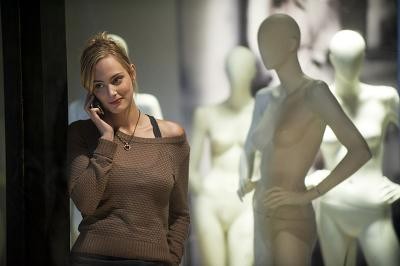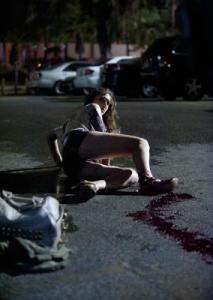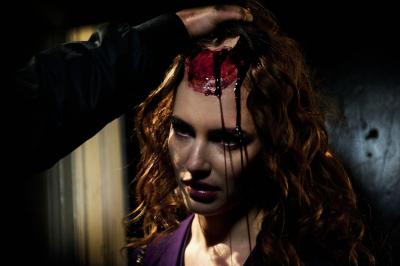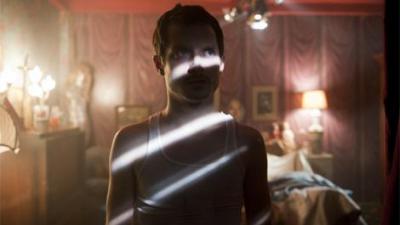By: debbie lynn elias
One of my greatest gripes about filmmaking stems from remakes. If a film is so well done or so beloved, it need never be remade unless the remake or reimagination adds something new, takes a new tact, etc. and doesn’t denigrate the vitality, excellence or classicism of the original. Having said that, Franck Khalfoun’s “remake” of William Lustig’s 1980 horror classic, MANIAC, is not only an as close to perfect remake as I have seen in many a day, but takes the concept and film to new levels of excellence and creativity that take the film beyond the horror genre.

Powerful and shocking in its day, Lustig’s MANIAC was beyond visceral and as Khalfoun relates, was described by some critics as “smell[ing] like piss.” In Lustig’s original, Joe Spinell (who also wrote the original screenplay) played Frank. Large, hulking, sweaty and grimy, Frank was a serial killer of grand proportion, terrorizing young women in 1980’s New York. The kills were bloody, brutal and voluminous. In this 2013 version from Khalfoun, the action shifts from the once-gritty New York City alleys to the now-gritty downtown Los Angeles alleys and empty nighttime streets. The delicate, kind and elfin Elijah Wood steps in as Frank who, while no longer hulking and menacing, is psychologically creepy. But the most important and effective twist on the original is Khalfoun’s shift of the POV to have everything seen through Frank’s eyes. The audience, in essence, becomes part of Frank.
Frank loved his mother and craved her love and attention in return. Unfortunately, he didn’t get it which resulted in some more than skewed psychological issues that plague him to this day. Now running his mother’s business of restoring vintage porcelain mannequins of days gone by, Frank obsesses with his mannequins, so much so, that he stalks females, stabs them, strangles them and then scalps them. He then brings the scalps home to his “ladies” and then staple-guns or glues the scalps to various mannequins which he also dresses in his victims’ clothing, now believing them to be “alive” and thus fulfilling his need for love and affection. Frank’s kind eyes and sensitive nature not only makes it easy to find victims, but makes everything that much more shocking and disturbing. (Think Norman Bates meets Hannibal Lector.)

But, could there be hope for Frank? Could he not be completely over the edge? Is there a chance of redemption? When he meets a beautiful young blonde photographer named Anna, it’s as if a weight has been lifted from him. His world gets a little lighter, a little brighter. He becomes engaged in conversation, coffee and business – especially when he discovers Anna’s own interest in faceless mannequins which she now wants to use in a one-woman multi-media art show. But what happens when Frank realizes that Anna has a boyfriend, and it’s not him.
Elijah Wood stuns! While diminutive in stature, he is anything but in performance power as Frank. Having said that, he harkens to the same creepiness of Tony Perkins in “Psycho”, but what makes Wood even more mesmerizing and chilling are his eyes. And given the whole POV aspect of the film, his blue, wide-eyed, over-sized oogly eyes add layers that no other actor could bring to the story. Interestingly, because of Khalfoun’s POV shift, not only are we treated to an entirely different emotional experience with Wood in the lead, but a larger hulking actor would have been unable to pretzel his physique in tune to the camera. As Wood notes, “My challenges were logistically getting myself behind the camera and figuring out ways to make sure that I was there for the other actors and also to get potentially an arm or a hand into frame at different times which could be cumbersome. But that was an exciting process. I found that whole process to be almost like a puzzle everyday. But it was a challenging process, too, because in some ways you walk into that thinking, ‘It’s simple, right? Everything’s one shot.’ But of course the limitations actually create more challenges because you can’t rely on traditional editing, you can’t rely on traditional coverage.”

Important to Wood’s performance is that not only had he not seen the original MANIAC, but intentionally waited until filming began on this version. This allowed him to “work to establish the character from my perspective without having seen what Joe Spinell did. However, Joe’s physicality, his voice, who he is, is never anything I could have been. The differentiation is so vast anyway but it was important to me to just create the character based on my interpretation and what was in the script.”
As Anna, Nora Arnezeder is ethereal joy. The character herself, and Arnezeder’s performance, is a purity that is metaphorically stated through the faceless pure white mannequins with her face then projected on them. A wonderful balance to the “sluttier” girls that Frank has been killing and a performance that creates a tonal shift in the story.

But talk about sending chills down your spine! Co-written by Alexandre Aja and Gregory Levasseur based on Spinell’s 1980 screenplay, and directed by Franck Khalfoun, MANIAC turns the tables and sets the mind reeling. Not your typical fear movie with things jumping out at you, the first-person point-of-view of having the camera see everything through Frank’s eyes is not only a brilliant idea, but masterfully executed thanks to cinematographer Maxime Alexander’s incredible lensing design. The camera angles are superbly designed and executed, immersing us in Frank’s psyche. Skewed, over the shoulder, eye level with Frank’s POV at all times, one of the most intense and exciting scenes involves Frank under a car in a parking garage near 6th & Broadway with only his hands, a knife and the ankles of a potential victim playing out. Heart-stopping. Although everything is seen through Frank’s eyes, we do get glimmers of Frank – but only through reflection – mirrors, windows, angles with just his eyes captured in a rear view mirror – all creates an intensity that is powerful, mesmerizing and riveting.
For Khalfoun, “My whole take on the way that this film look was obviously production design and cinematography. I wanted it to look beautiful and then I wanted it to be all drenched in darkness, sort of symbolizing this perhaps beautiful man who is now covered himself in darkness and trying to slowly to reveal himself, trying to come out of that. It just embodies the character. The problem with doing a movie in POV is that I have to use every other element to try and create emotion and create a sensibility. I knew that if I made a very lush, beautiful movie and then darkened it, that it would evoke some sort of feeling, some sort of mystery. You want the veil to be lifted as you want the veil to be lifted on this character as you want to discover, as you hope that this character will sort of lift himself out of this thing.”

In designing the visual tone, Khalfoun and Alexander create a rich and lush icy bluish noir lighting palette punctuated with the purity of the white faceless mannequins and the judicious pops of bright red blood, which over time, deepens to a dark crimson on the mannequins’ scalps, blurring the line ever deeper between horror and art house couture.
Interesting is Khalfoun’s take on the original film and it’s impact on him, something that carried through and was incorporated into this direction of MANIAC. On first seeing the film on VHS in the late 80’s, “My experience was ‘Wow! I have empathy for this monster.’ And I thought how human that is of me, no matter what this guy has done, I still feel something. I feel bad. I want to give him reasons and excuses for having done the things he that he had done. It became less gratuitous for me in that way. That’s what I brought into this one and that’s sort of the take that I started this venture on.” With that in mind, Khalfoun’s MANIAC became a structured point-of-view through Frank’s eyes. “Beyond it being a movie about a man slashing and scalping women, it’s a man looking for love, looking for acceptance, looking for a way out of his wounds of childhood.” What Khalfoun achieves beyond the beauteous visuals is an emotionally poignancy and drama of the human condition.

Achieving and maintaining the consistent first-person POV was not an easy task, not only for Elijah Wood, but for director Khalfoun as well. “[I]t’s a huge challenge because moviemaking is about following characters and feeling their experience and if you don’t see them, you’re stripped away of your lead character for the most part. So you have to substitute that for other things. Also, in terms of doing horror and suspense, it’s all about coverage and it’s all about stretching time and creating slowing down time so that you can raise tension and raise fear. If I’m doing everything from one point-of-view, all of a sudden I can’t cut to a close up of somebody’s feet or a hand grabbing a door knob to play with tension. And I knew those things. So it’s an incredible challenge. Also, not being able to see the main character and feel for this character. Elijah does a remarkable job because we don’t see his face a lot but when we do, it’s very impactful and his voice guides us through this and we’re able to sort of feel that emotion. So you have to substitute it in different ways and find other ways to do it.
Editing is rapier with its precision and pacing. Clean, sharp, razor-honed. Tension builds incrementally as the senses are assaulted with unrelenting shocking kills.

Noteworthy is that I screened MANIAC at a midnight show at the Chinese complex in Hollywood during which I detected discernible differentials in the audio track. Be it intentional or a technical glitch, the audio sounded like student films back in the 70’s when we had to use Super 8mm or 8mm to shoot film only and then do a separate audio track on reel-to-reel and time to match, running a projector and reel-to-reel player concurrently. The entire audio track of Wood’s Frank – and only his – sounded looped but looped over the complete audio of the existing tracks. Having said that, it works, whether it was deliberate or a technical glitch as it just makes Frank more “in your face”, “in your head space” and adds an even greater psychotic texture to the experience. Be it a technical issue or designed, Frank’s narrative is effectively disconcerting.
As Franck Khalfoun aptly notes, “Most of the horror movies that stand time are the ones that go beyond scares and actually tell human story. You can always tell a good horror film if you remove the horror.” Khalfoun’s MANIAC is about as human as one can get. A heart-pounding, heart-stopping cinematic experience.
Directed by Franck Khalfoun
Written by Alexandre Aja, Gregory Levasseur based on Joe Spinell’s 1980 screenplay
Cast: Elijah Wood, Nora Arnezeder











